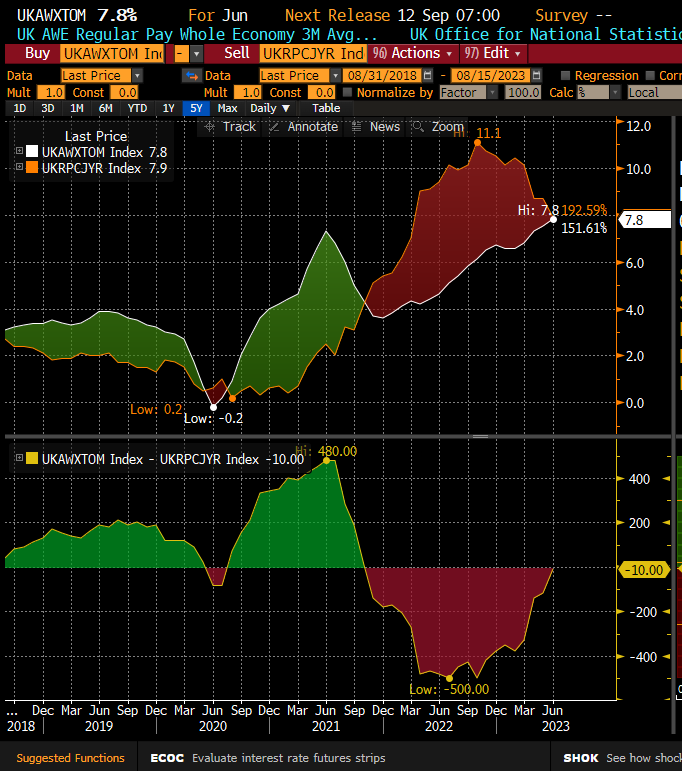There was always the likelihood that today’s unemployment and wages numbers would give the Bank of England a headache when it comes to deciding what to do when it comes to further rate increases, and this morning’s numbers have not just given the central bank a headache, but a migraine.
Not only has the unemployment rate jumped to its highest level since October 2021 at 4.2%, but wages growth surged in June, while the May numbers were also revised higher.
Average weekly earnings for the 3-months to June rose to a record 7.8%, while May was revised up to 7.5%, while including bonuses wages rose by 8.2%, in the process pushing well above core CPI inflation. This move to 8.2% was primarily due to NHS bonus one-off payments made in June, which is unlikely to be repeated.
The rise in wage growth saw public sector pay rise by 6.2%, while private sector wages rose 8.2% for the 3-months to June.
Inevitably this will increase the pressure on the Bank of England to raise rates again at its September meeting by another 25bps, even as headline CPI for July is expected to slow sharply below 7% in numbers released tomorrow.
On the broader employment picture there was a 97k increase in hiring during July as payrolled employees increased. On the overall UK employment rate, this fell back to 75.7%, and is still 0.8% below its pre-pandemic peak, with the economic activity rate also falling slightly to 20.9% on the quarter. Total hours work also declined.
While many people will decry the strength of these numbers and warn of the risk of wage/price spiral they rather miss the point that consumer incomes have been squeezed for months, with the gap finally narrowing, and now starting to work in consumer’s favour.
UK wages against UK CPI last 5 years
Source: Bloomberg
This trend is likely to continue in the coming months as wage growth starts to slow and falling CPI starts to find a base, offering consumers some relief from the squeeze of the last 18 months.
It’s also important to remember that wage price gap leading up the end of 2021, was very much in the consumers favour, however this comparison also comes with several caveats due to furlough payments and other support structures which skewed the numbers.
While today’s wages data will undoubtedly grab all the headlines, there are growing signs of weakness in the labour market which may offer the Bank of England pause, and with another 2 CPI reports, one tomorrow, as well as another labour market survey before the next meeting, it doesn’t mean that we can expect to see multiple rate hikes in the coming months. While the pressure on the Bank of England to hike in September has undoubtedly risen and is fully priced for September it doesn’t necessarily mean we’ll see more rate hikes after that. Trends are important and the Bank of England needs to think about that before it raises rates further, and inflation is trending lower. UK 2-year gilts have edged higher and back above 5.1%
The Bank of England needs to remember that they’ve already raised rates 14 times in the last few months and there is still a lot more tightening that has yet to kick in. On this data another rate hike does seem likely but when you look at the graph above perhaps there’s a case for a pause in September given the direction of that graph above. What today’s data does mean beyond little doubt is that rates will need to stay at current levels for longer. More rate hikes aren’t necessarily the solution to every problem. Just because every problem is a nail, doesn’t mean you need a hammer. Just leave rates where they are for longer.
Consumers are already struggling and although we’ve seen Marks & Spencer update its full year forecasts for profits this morning, the upgrade has come against a backdrop of a strong performance in its food business, which saw like-for-like sales rise 11%.
Clothing and home sales saw like for like sales rise by 6%, with M&S warning that a tightening consumer market could act as a headwind into the year end.
Tellingly, management upgraded their outlook to show profit growth in fiscal 2022-23.
Note: All information on this page is subject to change. The use of this website constitutes acceptance of our user agreement. Please read our privacy policy and legal disclaimer. Opinions expressed at FXstreet.com are those of the individual authors and do not necessarily represent the opinion of FXstreet.com or its management. Risk Disclosure: Trading foreign exchange on margin carries a high level of risk, and may not be suitable for all investors. The high degree of leverage can work against you as well as for you. Before deciding to invest in foreign exchange you should carefully consider your investment objectives, level of experience, and risk appetite. The possibility exists that you could sustain a loss of some or all of your initial investment and therefore you should not invest money that you cannot afford to lose. You should be aware of all the risks associated with foreign exchange trading, and seek advice from an independent financial advisor if you have any doubts.
Recommended Content
Editors’ Picks

Gold hits another record high near $3,375 on fresh safe-haven demand
Gold price drifts higher to a fresh record high near $3,375 in the Asian session on Monday after facing some profit-taking due to the long weekend. Uncertainty about US President Donald Trump's tariff policies and persistent geopolitical tensions continue to underpin the precious metal.

AUD/USD sits at two-month top near 0.6400 after PBOC leaves rates unchanged
AUD/USD hangs close to fresh two-month high near 0.6400 this Monday after the PBOC decided to leave the one and five-year Loan Prime Rates unchanged. The RBA's hawkish outlook supports the pair amid a bearish USD. However, the risk-off flows and concerns about the rapidly escalating trade war keep the upside capped.

USD/JPY slides further to 141.00, fresh low since September 2024
USD/JPY drops to a fresh seven-month low, testing 141.00 at the start of a new week as trade-related uncertainties and geopolitical risks continue to drive flows towards the JPY. The divergent BoJ-Fed expectations further exert pressure on the pair amid a bearish USD and thin liquidity during the Easter Monday holiday.

Week ahead: Eyes on flash PMIs as tariff uncertainty persists
Tariff headlines remain at the top of investors’ agendas. But flash S&P Global PMIs could attract special attention. Auctions to reveal information about demand for Treasuries. Tokyo CPI data and Canada’s retail sales also on tap.

Future-proofing portfolios: A playbook for tariff and recession risks
It does seem like we will be talking tariffs for a while. And if tariffs stay — in some shape or form — even after negotiations, we’ll likely be talking about recession too. Higher input costs, persistent inflation, and tighter monetary policy are already weighing on global growth.

The Best brokers to trade EUR/USD
SPONSORED Discover the top brokers for trading EUR/USD in 2025. Our list features brokers with competitive spreads, fast execution, and powerful platforms. Whether you're a beginner or an expert, find the right partner to navigate the dynamic Forex market.
